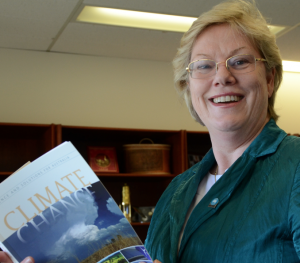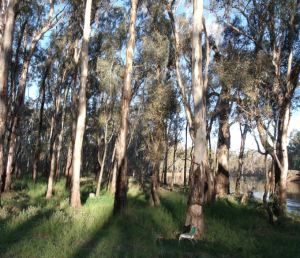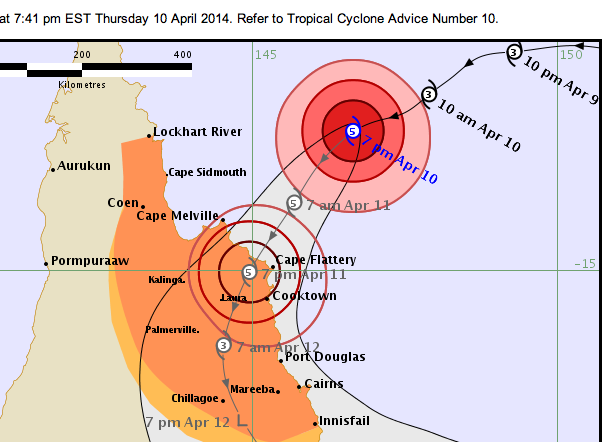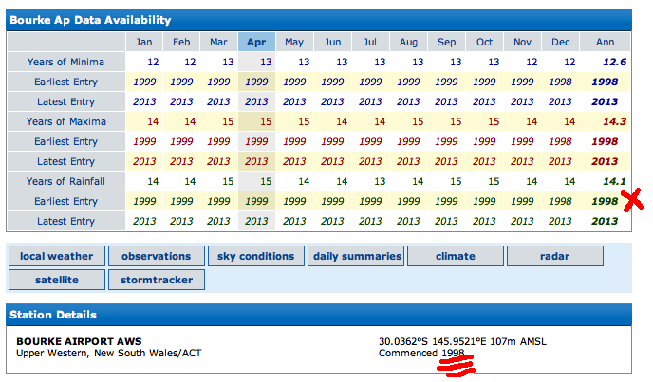I’ve been invited to speak at the 9th International Conference on Climate Change, sponsored by the Heartland Institute. Its in Las Vegas in July. The speakers list is now available and also a draft schedule. It looks like I will be speaking in a session with Dr Nils-Axel Morner from Stockholm University. I followed a link to his presentation on sea-level rise and fall given at the conference last year in Munich. It’s informative and entertaining…
CSIRO Has Lost Its Way, and Soon Its Funding
INNOVATION is critical to staying competitive.
Government-funded science and technology have played an important role in the past, but key institutions like the CSIRO have increasingly lost their way. 
Indeed the CSIRO, probably more than any other organisation, deserve the big funding cut that I hope is coming their way in the May Budget.
Australian agriculture has a bad reputation in many quarters. To a large extent this can be blamed on the many pronouncements by the CSIRO in their rush to corner funding first for salinity, then for biodiversity and water quality and more recently climate change research.
Between the 1950s and 1970s Australia built an outstanding national capability in real science.
At the time leadership did come from CSIRO, university researchers and also many state and federal government agencies.
With the 1980s, however, came a restructuring of the way things were done and how agencies and individuals were funded.
There was a move to project-based funding of a limited duration. So scientists had to identify problems and promote these problems if they were to secure funding – if they were to keep their jobs.
The Native Vegetation Act 2003 and the Murray Darling Basin Plan are direct consequences of the many CSIRO reports that have suggested Australia’s environment is ruin: give us more money to solve the problem.
These reports pronounce catastrophe, subtly paint the farmer as villain and have provided fodder for politicians ever keen to announce a funding allocation to solve a problem, and of course green-groups who’s very existence depends on saving an environment.
Dr Bill Johnston worked within the NSW departments concerned with natural resource management for 30 years. He recently sent me a note explaining that:
“A keystone report relating to the Murray Darling was ‘The Assessment of River Condition’ report published by CSIRO Land and Water in 2001. A snapshot of the Murray Darling’s health was modelled against a pre-European (1750) pristine baseline, for which there was no data.
“Unsurprisingly it found that by its definitions, most rivers were stuffed. Despite very thin data; supported by second and third tier modelling and a huge leap of baseline-faith, it was used relentlessly to on-market Murray Darling Basin facts for all that followed.”
Dr Johnston laments the disbanding of the NSW government’s research capability. He claims the Centre for Natural Resources (CNR) was the most active field-based Murray Darling Basin-focussed research group. He says, “CNR was disbanded, staff were moved so they were under the umbrella of CSIRO or an allied university institute.
“These and other changes left CSIRO and the Bureau of Meteorology dominant providers of natural-resource information and policy advice; modelling, as the preferred methodology; bell-ringing as the preferred communication strategy; and public discourse by scientists, especially about organisational policies and direction muzzled.”
*****
The image is of CSIRO Chief Executive Dr Megan Clarke.
This article was first published by The Land newspaper on May 1, 2014. A reader of The Land tells me the trouble started at CSIRO in about 1986 when management arrangements at the CSIRO changed, with the appointment of a Board headed by the politician Neville Kenneth Wran.
Bigots, Climate Change Deniers and George Orwell
GEORGE Brandis says it is “deplorable” deniers are being excluded from the climate change debate and people who say the science is settled are ignorant and medieval.
The attorney general called the leader of the opposition in the Senate, Penny Wong, the “high priestess of political correctness” and said he did not regret his comment that everyone has the right to be a bigot in an interview with the online magazine Spiked.
He said one of the main motivators for his passionate defence of free speech has been the “deplorable” way climate change has been debated and he was “really shocked by the sheer authoritarianism of those who would have excluded from the debate the point of view of people who were climate-change deniers”.
“One side [has] the orthodoxy on its side and delegitimises the views of those who disagree, rather than engaging with them intellectually and showing them why they are wrong,” he said…
“The moment you establish the state as the arbiter of what might be said, you establish the state as the arbiter of what might be thought, and you are right in the territory that George Orwell foreshadowed.”
And I’m quoting from Bridie Jabour writing in the The Guardian!
More Relevance in Indigenous Culture, Than ABC Culture
EASTER is about religion, which is about culture, which is about myth. I was raised on the myths of the Australian Outback, on the poems of Banjo Paterson where the heroes could be “hard and tough and wiry – just the sought that won’t say die”. The landscape was also tough, harsh, and certainly ready to break the individual who was not resilient and innovative. 
Modern Australia still likes a hero, but our relationship with the landscape has changed. The idea now is that we have broken the landscape, that collectively we have changed the environment and not for the better.
It’s generally acknowledged that all religions attempt two things: to explain existence and to regulate behavior. More than ever, Australians congregate in cities, carry on about greed destroying the environment, and campaign for more wildlife, wilderness and against climate change. Rural Australia receives much of this new culture through the Australian Broadcasting Corporation – through television and radio.
It’s interesting to reflect that in aboriginal culture, wilderness was not a cause for fond nostalgia, but rather a landscape without a custodian. Indeed for the first Australians the health of a landscape was measured less by how much water was in a river, and more by how many kangaroos it could support.
The new culture, however, is generally against the active management of “nature” – mankind’s role, and especially that of industry, is always portrayed in the negative. There is now a regime of legislation and regulation in place, supposedly promoting sustainability, but in reality it hampers good land management and would make no sense to either Clancy of the Overflow or the Dreamtime hunter, Ngurunderi.
Perhaps its time those with a real connection to the Australian landscape, with a real love of country, got together to talk about a new vision for the Outback. If you don’t have your own plan, chances are you will be implementing someone else’s.
Indeed it is possible that in embracing some of the Dreamtime myths rather than those of the environmentalists who feature so prominently as heroes on the ABC, we could all come to a more balanced understanding of the Australian landscape and its needs. Consider, for example, that in one Dreamtime story when Ngurunderi visited the River Murray’s mouth it was not brimming with freshwater as environmentalists insist was the case before irrigation, but had actually closed over. So Ngurunderi was able to walked across the Murray’s mouth from Tapawal into Ramindjeri country. That’s right, back in the Dreamtime, before irrigated agriculture, the Murray’s mouth had closed over.
****
The above article was first published as a column by Jennifer Marohasy in The Land newspaper. The Land is available in good news agencies across Australia.
The dreamtime story of Ngurunderi walking across the Murray’ mouth as told by Albert Karloan, one of the last three youths to undergo full initiation rites in the Lower Murray region is explained at the ‘Myth and the Murray’ website, http://www.mythandthemurray.org/when-ngurunderi-walked-across-the-murrays-mouth/ .
Cooper Creek Wilderness in Direct Path of Ita – UPDATED
SEVERE Tropical Cyclone Ita, Category 5, is expected to move in a general southwest direction towards the far north Queensland coast tonight and into Friday, while possibly intensifying further. That’s the advice at the Bureau of Meteorology website. 
Neil Hewett, who has contributed so many beautiful photographs to this website, and his beloved Cooper Creek Wilderness, are in the anticipated path of the cyclone.
I know Neil built the family home, nestled in the the oldest surviving rainforest on earth, with a cyclone bunker: a specially reinforced windowless pantry. That is where Neil and his family sheltered through Cyclone Yasi, a category five that hit the Daintree Rainforest in 2011.
Anyway, my thoughts will be with the Hewett family over the next couple of days.
Update: Hewett family and cassowaries survived Ita! Walking trails have already been cleared of debris and Cooper Creek Wilderness is back open for business. Neil expects that there will be increased flowering and fruiting over the next year, and perhaps even two breeding periods for the cassowaries, in response to the cyclone. More here…http://www.ccwild.com/enews/display.php?M=1776&C=46f0d1866283fd3d64930902be67673c&S=366&L=14&N=114
Rewriting the History of Bourke: Part 3, Shortening an Already Shortened Record
AT Bourke temperatures were carefully recorded at the post office for 125 years, from 1871 to 1996. But this record is ignored by those announcing new temperature records on local Bourke radio. They rely on a record that only goes back to 1998!
From about 1952 through until 1996 the Postal Service staff carefully read and recorded the weather in the Stevenson screen at 9am, 12noon, 3pm, 6pm and then went back to the post office each evening at 9pm, 3am – yes the temperature was read manually at 3am by Postal Service staff – and then again at 6am. This information was immediately relayed to the Bureau in Melbourne.
But go to weatherzone.com.au and it suggests that temperatures at Bourke have only been recorded since 1998. What a travesty. 
http://www.weatherzone.com.au/climate/station.jsp?lt=site&lc=48245
There have been complaints to the local radio station that keeps announcing record hot days on the basis of this much-truncated record; temperatures for Bourke back to 1998. The radio station says that it relies on weatherzone.com.au for its information. Complaints to weatherzone have resulted in comment that the Bureau are unable to merge data, and can only provide Weatherzone with information on a station by station basis with the ‘Bourke Airport’ the current open weather station for Bourke.
Meanwhile, when it comes to the generation of contrived temperature data for Australia’s annual average temperature anomaly the Bureau have merged the airport and the post office, in fact the post office has been subsumed by the airport. This data has also been shortened, from 1871 to 1910, and of course ‘homogenized’.
Another travesty.

 Jennifer Marohasy BSc PhD has worked in industry and government. She is currently researching a novel technique for long-range weather forecasting funded by the B. Macfie Family Foundation.
Jennifer Marohasy BSc PhD has worked in industry and government. She is currently researching a novel technique for long-range weather forecasting funded by the B. Macfie Family Foundation.